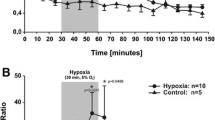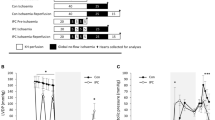Abstract
Intracellular pH (pHi) was measured with double-barrelled microelectrodes during 4 h of complete tourniquet ischemia in rabbit gastrocnemius muscle (group I). The pHi was related to extracellular pH (pHe), membrane potential (Em), tissue lactic acid (LA) and ATP. A fall in pHi from 7.00±0.03 to 6.60±0.05 occurred during 4 h of ischemia, with a slight pH-drop (0.07 pH units) during the initial hour and a more pronounced drop of 0.13 pH units during the last hour of ischemia. These changes were paralleled by a considerable decrease in pHe from 7.30±0.01 to 6.36±0.05 and a sixfold increase of tissue LA. The buffering capacity during the 4 h of ischemia was estimated to 81.9±5.6 mmol H+/l×pH. In parallel with the reduction in pHe, the resting membrane potential decreased from −90 mV and stabilised at around −60 mV after 2 h of ischemia. A less negative cell interior would favour H+ extrusion since the Em-EH + gradient was unchanged at about −70 mV during the entire period of ischemia. This could contribute to muscle fiber buffering during ischemia.
In another set of experiments (group II) the muscular glycogen reserve was reduced 20 min prior to a 4 h period of ischemia. Thereby an ischemic state was created where ATP levels decreased to 30% of initial, in contrast to the unaltered ATP content in group I. In the low-ATP group II the Em-EH + gradient decreased to 58% of initial and the buffering capacity was slightly but significantly lower (64.6±4 mmol H+/l×pH) than in the high-ATP group I. Significant correlation coefficients were obtained between the ATP loss and the Em-EH + gradient (r=0.861,P<0.001). These data suggest that maintenance of the transmembrane H+ gradient and to a certain degree the buffer capacity depend on the energy-state of the muscle cell.
Similar content being viewed by others
References
Adrian RH (1956) The effect of internal and external potassium concentration on the membrane potential of frog muscle. J Physiol (Lond) 133: 631–658
Agnew WF (1965) Effects of plasma tonicity on the distribution of water and solutes in brain and muscle. Exp Neurol 13: 58–70
Apstein CS, Deckelbaum L, Mueller M, Hagopian L, Hood WB (1977) Graded global ischemia and reperfusion. Circulation 55: 864–872
Armiger LC, Elliott TB, Fitzgerald S, Humphrey SM, Morrison MA, Seelye RN (1983) Effects of proton release from adenine nucleotide degradation during ischemic necrosis of myocardium in vitro. Biochemical Medicine 29: 265–277
Aukland K, Fadnes HO (1973) Protein concentration of interstitial fluid collected from rat skin by a wick method. Acta Physiol Scand 88: 350–358
Banks P, Bartley W, Birt LM (1978) The biochemistry of the tissues. Wiley, Chichester New York Brisbane Toronto, p 118
Bell DR, Watson PD, Renkin EM (1978) Exclusion of macromolecules in the interstitium of tissues from dog paw. Fed Proc 37: 314
Cohen RD, Iles RA (1975) Intracellular pH: measurement, control and metabolic interrelationships. CRC Crit Rev Clin Lab Sci 6: 101–143
Creese R, D'Silva JL, Shaw DM (1962) Interfibre fluid from guinea pig muscle. J Physiol (Lond) 162: 44–53
Davenport HW (1958) The ABC of acid-base chemistry. The University of Chicago Press, Chicago, pp 13–19
Fadnes HO, Aukland K (1977) Protein concentration and colloid osmotic pressure of interstitial fluid collected by the wick technique. Analysis and evaluation of the method. Microvasc Res 14: 11–25
Fiskum G, Lehninger AL (1979) Regulated release of Ca2+ from respiring mitochondria by Ca2+/2H+ antiport. J Biol Chem 254: 6236–6239
Gadian DG, Radda GK, Dawson MJ, Wilkie DR (1982) pHi measurements of cardiac and skeletal muscle using31P-NMR. In: Nuccitelli R, Deamer DW (eds) Intracellular pH: its measurement, regulation and utilization in cellular functions. Liss, New York, pp 61–77
Hagberg H, Larsson S, Haljamäe H (1983) A new design of double-barrelled microelectrodes for intracellular pH-measurements in vivo. Acta Physiol Scand 118: 149–153
Hagberg H, Jennische E, Haljamäe H (1985). Influence of tissue lactic acid and ATP levels on post-ischemic recovery in rabbit skeletal muscle. Circ Shock (in press)
Haljamäe H, Linde A, Amundson B (1974) Comparative analyses of capsular fluid and interstitial fluid. Am J Physiol 227: 1199–1205
Hess ML, Manson NH, Okabe E (1982) Involvement of free radicals in the pathophysiology of ischemic heart disease. Can J Physiol Pharmacol 60: 1382–1389
Hirche H-J, Schumacher E, Hagemann H (1980) Extracellular K+ concentration and K+ balance of the gastrocnemius muscle of the dog during exercise. Pflügers Arch 387: 231–237
Hultman E, Sahlin K (1980) Acid-base balance during exercise. Exercise and Sport Sci Rev 8: 41–128
Jansson E (1981) Acid soluble and insoluble glycogen in human skeletal muscle. Acta Physiol Scand 113: 337–340
Jennische E (1982) Relation between membrane potential and lactate in gastrocnemius and soleus muscle of the cat during tourniquet ischemia and postischemic reflow. Pflügers Arch 394: 329–332
Jennische E, Enger E, Medegård A, Appelgren L, Haljamäe H (1978) Correlation between tissue pH, cellular transmembrane potentials and cellular energy metabolism during shock and during ischemia. Circ Shock 5: 251–260
Jennische E, Hagberg H, Haljamäe H (1982) Extracellular potassium concentration and membrane potential in rabbit gastrocnemius muscle during tourniquet ischemia. Pflügers Arch 392: 335–339
Kalimo H, Rehnerona S, Söderfeldt B, Olsson Y, Siesjö BK (1981) Brain lactic acidosis and ischemic cell damage. 2. Histopathology. J Cereb Blood flow Metabol 1: 313–327
Klitzman B, Duling BR (1979) Microvascular hematocrit and red cell flow in resting and contracting striated muscle. Am J Physiol 237: H481-H490
Kost GJ (1984) Surface pH of the medial gastrocnemius and soleus muscles during hemorrhagic shock and ischemia. Surgery 95: 183–190
Ladegaard-Pedersen HJ, Engell HC (1972) A comparison of the distribution volumes of inulin and 51 Cr-EDTA in man and nephrectomized dogs. Scand J Clin Lab Invest 30: 267–270
Larsson J, Hultman E (1979) The effect of long-term arterial occlusion on energy metabolism of the human quadriceps muscle. Scand J Clin Lab Invest 39: 257–264
Lenz GR, Martell AE (1964) Metal complexes of carnosine. J Biochem 3: 750–753
Lowry OH, Passoneau JV (1972) A flexible system of enzymatic analysis. Academic Press, New York
Lowry OH, Rosebrough NJ, Farr A, Randall RJ (1951) Protein measurement with the Folin phenol reagent. J Biol Chem 193: 265–275
Masoro EJ, Siegel PD (1971) Acid-base regulation: its physiology and pathophysiology. Saunders, Philadelphia London Toronto, pp 32–33
Moody WJ (1982) Intracellular pH regulation: A summary of the proposed mechanisms and meeting discussion. In: Nuccitelli R, Deamer DW (eds) Intracellular pH: its measurement, regulation and utilization in cellular functions. Liss, New York, pp 283–287
Myers RE (1977) Lactic acid accumulation as a cause of brain edema and cerebral necrosis resulting from oxygen deprivation. In: Korobkin R, Guilleminault G (eds) Advances in perinatal neurology. Spectrum, New York, pp 85–114
Myrhage R, Hudlicka O (1976) The microvascular bed and capillary surface area in rat extensor hallucis proprius muscle (EHP). Microvasc Res 11: 315–323
Roos A, Boron WF (1981) Intracellular pH. Physiol Rev 61: 296–440
Ruch TC, Patton HD (1965) Physiology and biophysics. Saunders, Philadelphia London, p 912
Russell JM, Boron WF (1982) Intracellular pH regulation in squid giant axons. In: Nuccitelli R, Deamer DW (eds) Intracellular pH: its measurement, regulation, and utilization in cellular functions. Liss, New York, pp 221–237
Singer RB, Hastings AB (1948) An improved clinical method for the estimation of disturbances of the acid-base balance of human blood. Medicine 27: 223–242
Sorokina ZA (1972) Hydrogen ion role in active transport of potassium and sodium through neuron membranes in the snail Helix Pomatia. Zhurnal Evolytsionoi Biokhimii i Fiziologii 8: 45–51
Tamaki N, Nakamura M, Harada M, Kimura K, Kawano H, Hama T (1977) Anserine and carnosine contents in muscular tissue of rat and rabbit. J Nutr Sci Vitaminol 23: 319–329
Thomas RC (1978) Ion sensitive intracellular microelectrodes: how to make and use them. Academic Press, London New York
Threlfall CJ, Stoner HB (1957) Studies on the mechanism of shock. The effect of limb ischemia on the phosphates of muscle. Brit J Exp Pathol 38: 339–356
Trivedi B, Danforth WH (1966) Effect of pH on the kinetics of frog muscle phosphofructokinase. J Biol Chem 241:4110–4114
Van Slyke DD (1922) On the measurement of buffer values and on the relationship of buffer value to the concentration and reaction of the buffer solution. J Biol Chem 52: 525–570
Wilke R, Angersbach D (1981) Metabolic and pH changes in muscle during and after ischemia in the rat hind-limb Bibthca Anat (20): 547–552
Author information
Authors and Affiliations
Rights and permissions
About this article
Cite this article
Hagberg, H. Intracellular pH during ischemia in skeletal muscle: relationship to membrane potential, extracellular pH, tissue lactic acid and ATP. Pflugers Arch. 404, 342–347 (1985). https://doi.org/10.1007/BF00585346
Received:
Accepted:
Issue Date:
DOI: https://doi.org/10.1007/BF00585346




